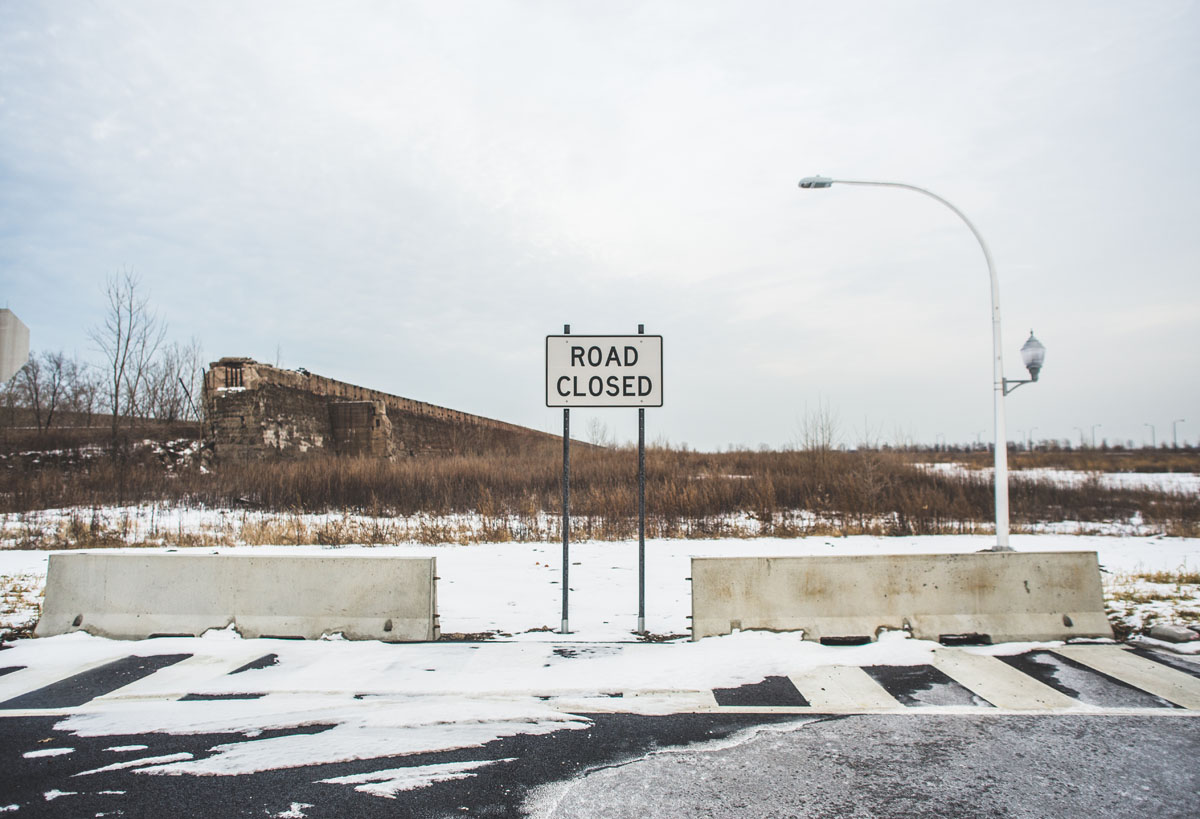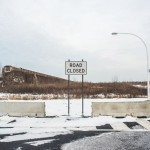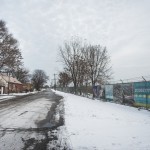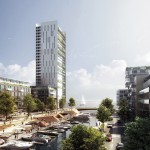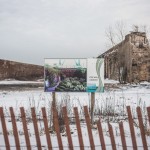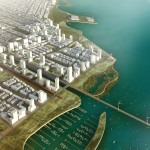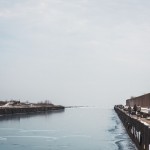On the morning of October 26, Rahm Emanuel stood on an imposing stage at the intersection of 79th and South Shore Drive. He was surrounded by a throng of onlookers, cameramen, security guards, and a high school marching band. Behind him, the parking lot of the South Shore Food & Liquor shop, which is usually filled with people chatting, was empty.
While the crowd looked on, Mayor Emanuel celebrated the expansion of Lakeshore Drive along the South Side. The extension, which had been under construction for over a year, now runs from 79th Street through the old South Works US Steel plant and down to 92nd Street, where it becomes Avenue O and then US 41.
“It shows,” said Emanuel of the new road, “that when you open up a road, a runway, a train line, you unlock all this economic potential, all this economic opportunity.”
Emanuel was followed by aldermen, senators, and spokespeople from the Chicago and Illinois Departments of Transportation, all of whom shared optimism about the expanded Lakeshore Drive.
“This is more than just bricks and mortar,” said 10th Ward Alderman John Pope. “It’s an opportunity to realize what we all need and want in this side of the neighborhood.”
Much of this economic opportunity, the speakers seemed to think, will come from the Lakeside Development, an enormous planned community to be built on the site of the old US Steel plant, through which Lakeshore Drive now runs. The ceremony itself took place on a podium decorated with computer-generated sketches of the development, while several of the speakers who stood on it made nods to McCaffery Interests, the real estate company behind Lakeside.
Advertised as a “global initiative for innovative living” and billed as the largest planned community in the country, Lakeside will feature 15,000 residential units, more than seventeen million square feet of “retail, restaurants, commercial, institutional, and research facilities,” miles of new parkland, a new high school, and a full-service marina. McCaffery Interests, which also built the mixed-use Roosevelt Collection development in the South Loop and numerous other projects across the country, expects that at 600 acres, Lakeside will take up to forty-five years to complete, and in the process will create 97,800 construction jobs, 13,900 retail jobs, and 27,800 commercial and institutional jobs.
The Lakeside website claims that construction has already begun on “Phase 1” of the development, an 800,000 square foot “Market Common” with retail and residential uses to be built on the vacant land between 79th and 82nd Streets, west of the new Lakeshore Drive.
Dan McCaffery of the eponymous McCaffery Interests, however, found himself on a rougher patch of road. During Mayor Emanuel’s speech at the podium, people in the crowd started to shout in protest, drawing the grim attention of the press and security in the crowd. Immediately after the ribbon was cut, a dozen angry local residents—the same residents whom Alderman Pope thanked during his speech for their “patience” and “understanding”—surrounded McCaffery, who had been on the stage with the other dignitaries. They shouted at him, condemning his plans to build the high-income retail Lakeside Development in the middle of their neighborhood.
“‘Where’s the justification?” demanded one woman. “This is what happens, you guys wanna displace us.”
“I’m Dan,” said McCaffery. “What’s your name?”
“We were the ones shouting during your speech.”
“No problem.”
“But it is a problem.”
“No, I mean, no problem that you did that, you have every right to do it.”
“We don’t need a new road,” said another woman. “We need jobs. These houses are underwater, we got all kinds of vacant and abandoned homes.”
“I agree with you,” said McCaffery. “You know what I do? You can come and see me. Don’t be afraid, I’m on the 18th floor…”
“You gotta come and see the whole community,” said another woman.
“Somewhere down the line,” said another man to McCaffery, “you guys decided, ‘Hey, real estate is a big sell, so that’s what we’re gonna do.’ Why don’t you return to manufacturing? We need jobs.”
“Write down your suggestions,” said McCaffery.
“They’ve been written down before,” protested the man.
After a while, McCaffery broke away from the crowd.
“I gotta go mix and mingle,” he said, stepping away.
The crowd dispersed, but some of its more vocal members stuck around.
“What the city should do is return to initial proposals where they said that over sixty-five percent of the land would be used for manufacturing purposes,” said a man named Robert. “What they could do is reallocate TIF [Tax increment financing] funds that have been allocated for Phase 1 of Lakeside construction back to our neighborhood schools, and back to our neighborhood.”
“We need manufacturing jobs, we need eighty-five percent of these new jobs to be for the 7th Ward,” said Dorian Myrickes, who is campaigning for 7th Ward alderman. “We do need retail, we do need restaurants, but we need manufacturing, technology jobs that are gonna be liable for the future.”
Alderman Pope, whose ward sits south of 83rd Street, was positive about the effects the new road will have on the future of the community.
“Rerouting Lakeshore Drive onto this site allows for relief of the old route, which has many curves and signals and isn’t conducive to efficient traffic,” said Pope. “It’ll offer a safer lifestyle for the residents here, and this is a primarily residential neighborhood.”
However, most South Chicagoans seem to be more concerned with the long-term consequences—namely, the construction of a Loop-scale retail district in their backyards—of the Lakeshore Drive expansion, rather than its short-term conveniences.
“You gotta remember those meetings where they told us they were gonna bring all these jobs here,” said Robert. “And now, they turn around, it’s all retail. They wanna make this whole area like Navy Pier, all along the lake.”
The wide lanes and clean sidewalks on the pristine new Lakeshore Drive strike a remarkable contrast against the decaying stone walls and overgrown fields, which are all that remain of the South Works steel plant.
“Thirty years, they’re gonna have everything down here,” mused a McCaffery security guard stationed at 87th Street. “New school, new shops, new everything. I’ll be long gone, that’s for sure, but it’s gonna be the place to be.”
And at 87th and Burley, just off the new road, lies both old and new: on one side of the street is a small, run-down Mexican Auto Parts shop. On the other side of the street is the Chicago Velodrome, a new circular track built for high-speed bicycle races. The Velodrome, whose entrance into the neighborhood is a saga in its own right, is cordoned off from the street by fences decorated with McCaffery posters advertising a futuristic Lakeside community in which residents might watch exciting bike races at the Velodrome. Other posters salivate over massive parking spaces, hyper-efficient and eco-friendly infrastructure, glistening townhouse complexes, massive marinas, and a seemingly endless host of other amenities.
A few weeks after the ribbon-cutting ceremony, Lakeside project manager Nasutsa Mabwa explained the potential of the development and McCaffery’s vision for the future of the community.
“Before we were here, there was a steel mill, there were thirty thousand people working here, there was heart,” said Mabwa. “Now that’s been destroyed, and it has to be reborn. It’s kind of like a Daniel Burnham project for the next several hundred years. It has civic implications. It will have a legacy.”
Mabwa listed the numerous things Lakeside will bring to the community, the new stretches of lakefront and parkland, the new retail and commercial outlets, the brand-new school, and thousands of new residential units. She discussed the potential for a new light rail line through the site, and possible connections with the University of Chicago, among them new student housing and a satellite campus. In Mabwa’s telling, however, Lakeside’s purpose is to offer a sense of community and belonging to an area that has long been deprived of such necessities.
“There is no sense of place on the South Side,” said Mabwa. “If you’re in Lincoln Park, you know where to go to get a sense of place, to feel accessible. If you’re in Lakeview, you know where to go. Any neighborhood in the city, you know where it is. Where is that here? This can be the South Side’s place where you can have open space, to belong.”
The expansion of Lakeshore Drive, according to Mabwa, was a crucial first step in opening up the steel mill site to future development.
“Our fearless leader Dan McCaffery, when he heard about the city’s plan to extend the road, he saw the opportunity,” said Mabwa. “Pulling the new [Lakeshore Drive] through the site, creating bike lines, sidewalk, intersections, community space, that’s what you have to do. You can’t just make a highway with on and off ramps.”
The new road, Mabwa said, will serve as a catalyst and anchor for Phase 1 of Lakeside, but added that the nature of the phase is currently uncertain.
“We do have a TIF for Phase 1,” said Mabwa. “We do want to put in mixed development and retail. We do want to put in rental housing. We will. But things are going to go where they need to be at that time, and we’ll respond to the private sector.”
A timeline on the wall of the Lakeside Development office claims that Phase 1 will reach completion between 2015 and 2017, but when asked about the timeline, Mabwa quickly said, “That timeline is not for you. When retailers come to Lakeside, they want to understand how the phasing works. Real estate changes all the time. It responds to the marketplace, so it’s constantly in flux.” This timeline is still available for viewing on the Lakeside website.
On an off-road drive in a McCaffery SUV through the ruins of the old steel plant, the sheer scale of the Lakeside project becomes apparent. The site is enormous, more than double the size of the Loop. Even on a clear day the empty land reaches as far as the horizon. The vast majority of the land is still completely barren except for a lonesome crane and some piles of mud. From the shoreline on the north end, at 79th Street, one can see the downtown Chicago skyline; this vantage point is a proposed location for the Barack Obama presidential library.
On the southern end of the site, near the old ore wall that Mabwa says will be converted into a monument to US Steel workers in the old mill, local citizens were fishing on land that has been closed for five years. Some cast out their lines from the newly opened Park 523 at the end of 87th Street, which Alderman Pope hopes will be renamed Steel Workers Park. Others fished right off the concrete dock just beneath the ore wall.
Mabwa looked out the SUV window at them and expressed her excitement at the fact that people had already started using the reopened space for recreation.
On a Friday afternoon almost a month after the SUV ride through the site, after snow had started to fall, there were still people fishing from the makeshift pier created by the ore wall. A hired security guard, however, arrived to kick them off about halfway through the afternoon.
The juxtaposition between the utopian images on McCaffery’s publicity posters and the massive spread of brush through which Lakeshore Drive now runs is profound. One can imagine department stores and apartments towering where there is now nothing but grass and abandoned metal, and one wonders what will happen to the Mexican Auto Parts shop and to South Shore Food & Liquor, or, for that matter, to the South Chicago residents who will soon live in the shadow of “the biggest planned development in the country.”
Many residents don’t believe that Lakeside could be built in South Chicago without any negative effects on the community.
“I can’t see this coexisting with the community they’re planning to build over the next thirty years,” said Kingsley Clark, another longtime resident of the South Side. “I can’t imagine that yuppies will want to buy condos right next to this neighborhood as it looks now, and I don’t see who in this community could be helped by Lakeside.”
UofC sociology professor Kathleen Cagney, who specializes in social inequality and health in urban neighborhoods, explained that there is no historical example of a development of Lakeside’s nature.
“There’s no ‘usually,’ ” said Cagney. “It’s a very different kind of circumstance. I’ve not seen an example like this in the United States.”
Cagney went on to add that Lakeside is not only much bigger than most urban redevelopment efforts, it is also a redevelopment of an empty industrial space, rather than an existing residential area.
“Typically what you would see is it would be a three or five block radius where some buildings would be razed and then there would be some sort of exodus or replacement of population, but that’s not the nature of the beast here,” said Cagney. “One could make the argument that there might be spillover that could lead to gentrification or replacement of population at the circumference of the site, but that land isn’t owned by McCaffery.”
Cagney concluded by saying she was unsure what the fate of the South Chicago community would be. She said she thought a community as diverse as Lakeside could provide “social anchors” for residents of the South Side.
“But,” said Cagney, “we also have to think about this: if [these social anchors] aren’t emerging directly from the community, should we then do nothing?”
Where some residents of South Chicago see a foreign force encroaching on their community, Mabwa and McCaffery seem to see potential for economic and civic improvement.
“Public transportation, jobs, community center, recreation, concerts, parks,” said Mabwa. “Why wouldn’t you want Lakeside? There’s nothing negative about it at all. The only thing that’s hard for some folks is it’ll be long, and it’s change.”
Both parties, however, agree that the effects of the Lakeside Development on the community will become apparent sooner rather than later. Although McCaffery already held the ceremony on 79th Street to celebrate the completion of the new Lakeshore Drive, it is clear to everyone involved that the real story is just starting to break ground.
At the Lakeshore Drive unveiling ceremony, Senator Dick Durbin approached the podium, decked with images of a South Chicago trademarked by Lakeside. Senator Durbin left the crowd with a few words of his own: “Here we are today, at this important day in history. Not just opening a new passageway for the people who live in this neighborhood, but also showing that when we work together and invest our tax dollars wisely, we can create jobs and economic opportunity.” The pictures may have been pretty, and the current situation may be desolate, but the crowd still grumbled at the future that might be in store for South Chicago.

